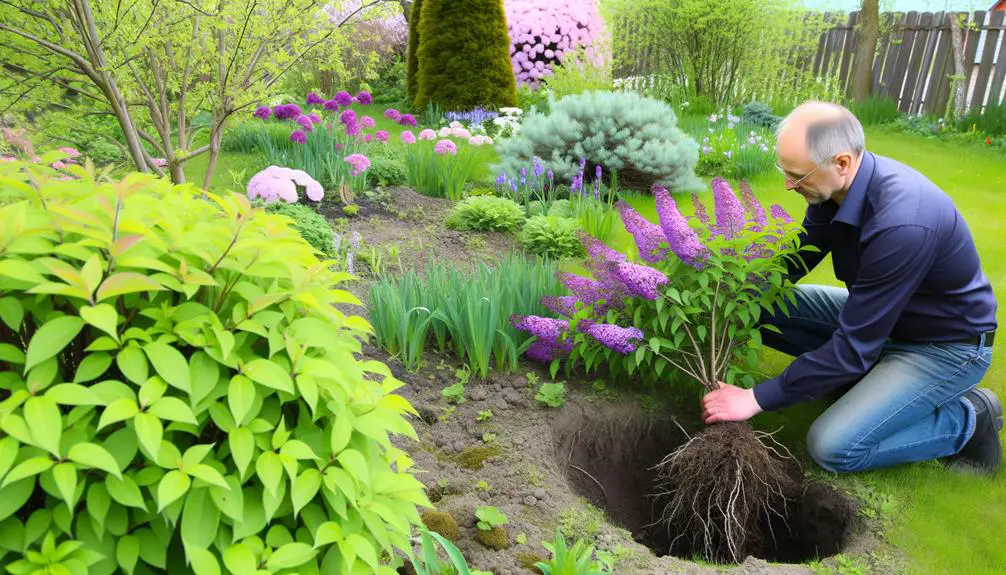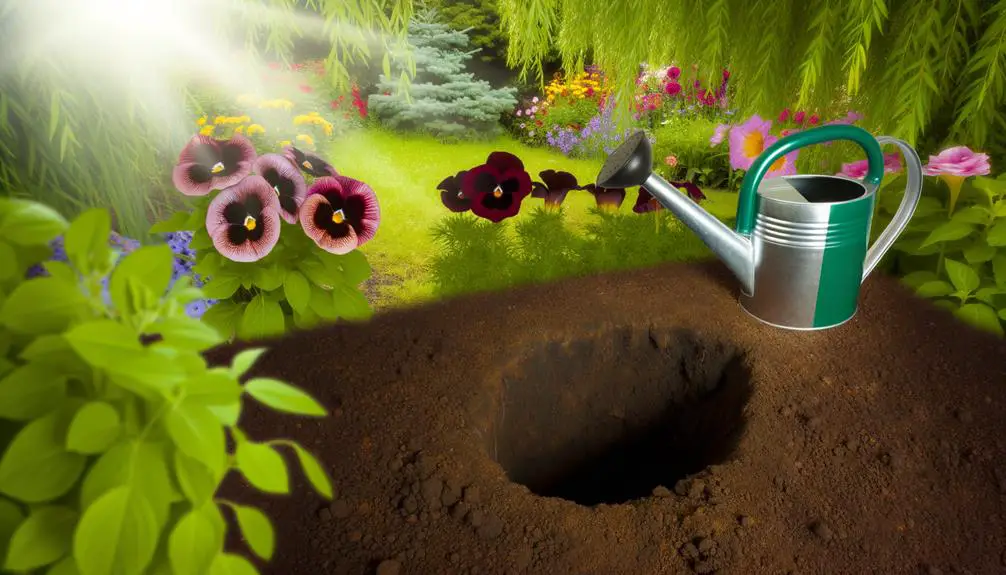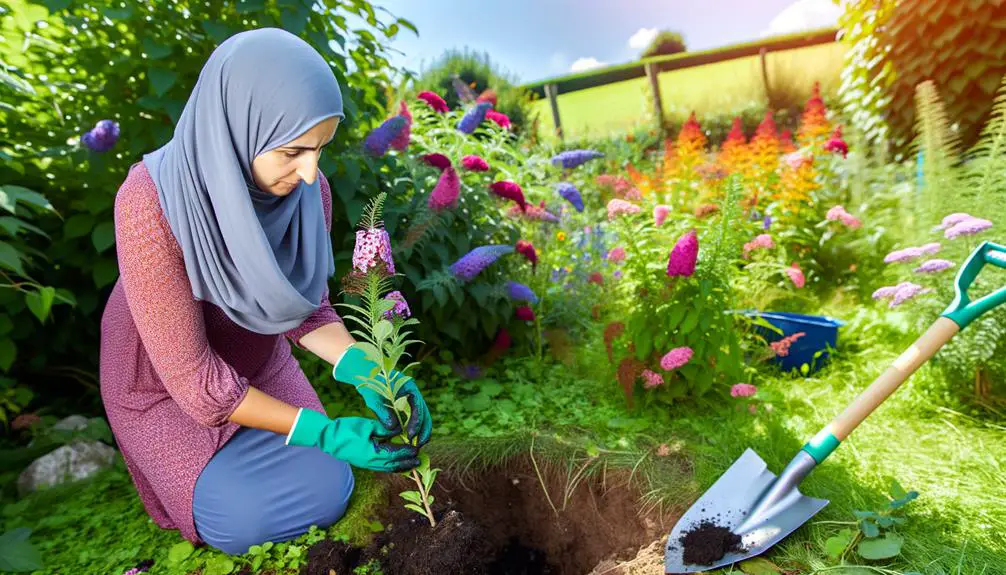10 Steps for Transplanting a Butterfly Bush: Timing and Techniques
Transplanting a butterfly bush (Buddleja spp.) is most effectively performed in early spring or late fall when the plant is dormant. This minimizes transplant shock and allows root establishment before new growth or winter dormancy.
Choose cool, overcast days with temperatures ranging from 50-60°F (10-15°C) to reduce water stress. Prepare a site with well-drained soil and full sun exposure, ensuring the pH is between 6.0 – 7.5.
Dig a hole twice the width of the root ball and maintain consistent soil moisture post-transplant. Applying mulch can help retain moisture and regulate temperature.
For further details on each step, continue exploring.

Key Takeaways
- Ideal transplant times are early spring or late fall.
- Transplant during dormant periods to minimize shock.
- Cool, overcast days are best for reducing water stress.
- Ensure soil temperature is between 50-60°F (10-15°C).
Best Time of Year

The ideal time to transplant a butterfly bush (Buddleja spp.) is during the early spring or late fall when the plant is dormant and less likely to experience transplant shock.
Dormancy occurs when metabolic processes slow, reducing water and nutrient requirements.
Early spring, before buds break, allows roots to establish in the new location before active growth begins.
Conversely, late fall, after leaf drop, provides similar advantages by minimizing stress during root disturbance.
This timing leverages natural seasonal rhythms, ensuring the plant can reestablish its root system without the added burden of supporting active foliage.
Proper seasonal timing is critical for successful transplantation, fostering resilience and robust growth in the subsequent growing season.
Ideal Weather Conditions
Ideal weather conditions for transplanting a butterfly bush involve cool, overcast days with mild temperatures to minimize water loss and stress on the plant. These conditions are ideal because they reduce the rate of transpiration and help maintain soil moisture, which is vital for the establishment of the root system. Transplanting during early spring or late fall is recommended, as these seasons typically provide the necessary climatic conditions. Avoiding extreme temperatures and full sunlight can further guarantee the plant's successful adaptation.
| Condition | Ideal Range | Impact on Transplanting |
|---|---|---|
| Temperature | 50-60°F (10-15°C) | Reduces water stress |
| Cloud Cover | Overcast | Minimizes sunlight exposure |
| Wind Speed | Low | Prevents desiccation |
| Soil Moisture | Consistently moist | Aids root establishment |
| Humidity | Moderate | Maintains leaf hydration |
Preparing the New Location

After identifying ideal weather conditions for transplanting, the next step involves meticulously preparing the new location to guarantee the butterfly bush thrives.
Select a well-drained site with full sun exposure, as Buddleia species require substantial sunlight for peak growth.
Conduct a soil pH test, aiming for a range between 6.0 and 7.5, which fosters nutrient availability. Amend the soil with organic compost to enhance fertility and structure.
Plan the transplant for early spring or late fall when the plant is dormant, minimizing transplant shock.
Dig a hole twice the width and equal depth of the root ball to promote root expansion.
Ascertain the new site remains free from competing vegetation, which can impede the butterfly bush's establishment.
Digging Up the Bush
Carefully excavate a trench around the butterfly bush, maintaining a radius of approximately 12 to 18 inches from the plant’s base to guarantee minimal root disturbance. Dig to a depth of at least 12 inches, ensuring you capture as much of the root system as possible. Gently lift the plant from the ground, keeping the root ball intact to promote successful transplantation. For optimal care, follow butterfly bush pruning tips to encourage healthy regrowth and abundant flowering.
Utilize a sharp spade for creating clean cuts and maintaining the integrity of the root ball.
Start digging in early spring or late fall, when the plant is dormant, to reduce transplant shock.
Gradually deepen the trench, working to a depth of at least 12 inches.
As you reach the required depth, gently rock the bush to loosen the root system from the soil.
Confirm you retain as much of the root ball as possible.
This meticulous approach preserves crucial roots, enhancing the bush's chances of successful acclimatization in its new location.
Transplanting Steps

Consistently guarantee the new planting location is prepared in advance, with a hole twice the width of the root ball and of sufficient depth to accommodate the transplanted butterfly bush. This preparation is essential to facilitate root expansion and ideal nutrient absorption.
Transplanting should ideally occur in early spring or late fall, ensuring the plant is in a dormant state, thereby minimizing transplant shock.
Gently place the butterfly bush into the hole, ensuring the root collar is level with the surrounding soil.
Backfill with a mixture of native soil and organic compost, eliminating air pockets by firmly pressing the soil.
Properly water the transplanted bush immediately to settle the soil and initiate root-soil contact.
Post-Transplant Care
Proper post-transplant care is essential to guarantee the successful establishment of the butterfly bush in its new environment.
Immediately after transplanting, water the plant thoroughly to settle the soil and eliminate air pockets. Maintain consistent moisture levels, especially during the initial weeks, ensuring the soil remains damp but not waterlogged.
Mulching around the base helps retain moisture and regulate soil temperature. Monitor for signs of transplant shock, such as wilting or yellowing leaves, and provide shade if necessary. Pruning any damaged branches can also promote healthier growth.
Fertilization should be deferred until after the bush shows signs of new growth, typically in the following spring. Regularly inspect for pests and diseases, applying appropriate treatments as needed.
Conclusion
Transplanting a butterfly bush necessitates meticulous planning and precise execution, akin to a well-choreographed symphony.
The ideal period for this endeavor is during the dormancy of late autumn or early spring, under cool, overcast conditions.
Adequate site preparation, careful extraction, and correct replanting techniques are critical.
Post-transplant care, including consistent watering and mulching, fosters successful establishment.
Adhering to these guidelines guarantees the butterfly bush will once again flourish in its new habitat.






